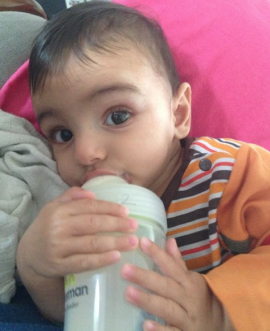Making the transition
Do you want to introduce a Suckle Feeder to your routine? Here are some tips to help a smooth transition.
So you want to introduce a Feeder to your routine?
If you have managed to breastfeed, even for a little while, WELL DONE :)
Establish breastfeeding
Most lactation experts advise waiting until your baby is at least a month old, so breastfeeding will be well established before you introduce a bottle.
 Practice time
Practice time
If you're returning to work, it is a good idea to introduce bottle feeding at least two weeks ahead of time, so you get used to expressing and your baby has time to get used to using the bottle.
Milk supply
If you are going to give your baby formula milk, rather than expressed breast milk, your milk supply will reduce and may make breastfeeding more difficult.
Reassurance
If you are going to bottle feed, particularly if you are starting work, or spending some time away from your baby, make sure to catch up on cuddle time! Your baby will need lots of reassurance and physical contact to help him feel emotionally secure.
Express milk
Returning to work is hard enough without feeling you must stop breastfeeding. Breastfeeding is an important way to re-establish the closeness with your baby when you’re at home. You can either express milk for your baby while at work or give formula. Your milk supply will adapt accordingly.
Tips for a smooth transition to the Suckle Feeder
Be patient and stay relaxed. Your baby will pick up on your mood.
Invite your baby to feed. If your baby is very young and still has the rooting reflex, try touching his cheek or lips with the teat and wait for his mouth to open wide and seek the mouthpiece, before putting it in his mouth.
Have a play. Let your baby get used to the Suckle Feeder's teat before attempting to feed properly. He might start off by chewing and then try out a few suckles.
 Use the Haberman variable flow. Start with the Suckle Feeder held so that the teat is in the 'no-flow' position until your baby has accepted it, then gradually turn it to start the milk flow. Make sure his tongue is under the teat before starting milk flow.
Use the Haberman variable flow. Start with the Suckle Feeder held so that the teat is in the 'no-flow' position until your baby has accepted it, then gradually turn it to start the milk flow. Make sure his tongue is under the teat before starting milk flow.
Introduce the Suckle Feeder when your baby is not desperate for a feed. Try in the evening after the regular breastfeed. Start with a small amount of breast milk; no more than 30 mls so you don't waste your precious expressed milk.
Let someone else feed the first bottle. If you try to give your baby the first bottle, he is likely to object and demand the breast. Ask your partner, family or friends to help.
Try to be out of the house. Your baby can smell you (even from a distance) so he may know that you (and your boobs) are just in the next room.
Position. Whilst some babies like to be held in breastfeeding positions when drinking from a bottle; others find it disconcerting. The Suckle Feeder enables feeding in a more upright position which is better for your baby's digestion, so experiment to find the best position for you and your baby.
Reassurance. Breastfeeding provides a lot of 'skin to skin' contact. The person who gives the bottle should try to maintain skin contact when bottle feeding too. Eye to eye contact and a happy soothing voice are also important. Your baby will find these things very reassuring. Give your baby time to get used to this new experience.
Distraction. Some parents find the gentle movement of walking or swaying helps when offering a bottle. Others have more success if all distractions are removed and they are in a quiet darkened room.
Good to know: If your baby cries and rejects the Suckle Feeder, back off, comfort him, and then try again. Have three attempts but if he still won't take the Suckle Feeder, leave it. You don't want to turn your attempts at feeding into a battle as it will make matters worse for next time your try. Wait at least an hour (if you can) before giving a breastfeed. You don't want your baby to associate persistent rejection of the bottle with getting the breast.
Some babies don't eat very much when their mum isn't home. If you are away all day your baby may begin waking more frequently at night. If possible allow for a settling in period at work because you may feel more tired than usual.
Help! I've followed the tips but my baby still won't take the Suckle Feeder. Try to:
Warm the teat to body temperature.
Tastes familiar. Put some breast milk on the teat so it tastes familiar.
Try out a different position. Try feeding your baby on your lap with his back to your chest or put him in a baby chair and feed him the bottle while facing him. When he is familiar with the bottle you can revert to your preferred position.
Be patient and stay calm. Feeding with your Haberman Suckle Feeder should soon become a relaxed and pleasurable experience for you and your baby.
Please Contact us if you have any specific difficulties you would like help with.
For more information on the benefits of the Haberman Suckle Feeder go to Frequently Asked Questions.








